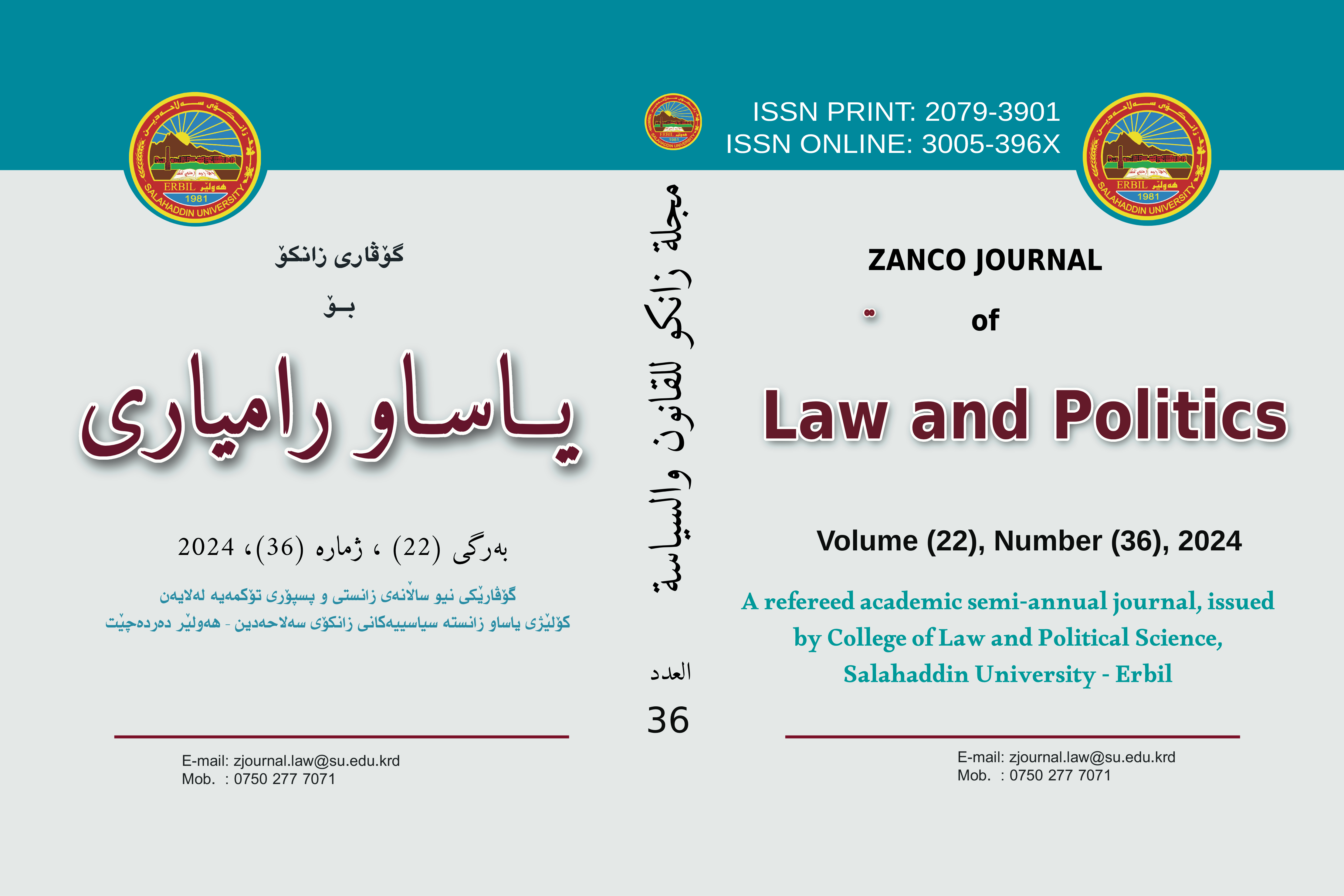The Role of ICRC in Establishing Protected Areas
DOI:
https://doi.org/10.21271/ZJlP.22.36.2Abstract
Abstract
The protection of civilians and hors de combat in armed conflicts has been a paramount concern for the International Committee of the Red Cross (ICRC). In this vein, protected area as a protective mechanism has emerged as a significant measure to safeguard civilians and provide safe haven during armed conflicts within the framework of international humanitarian law (IHL). This paper explores the ICRC's endeavours in negotiating, establishing and overseeing protected areas during various armed conflicts. The paper is an analytical study analysis the legal basis and practical aspects of ICRC's involvement in shaping the notion of protected areas for civilians amidst conflict zones. It examines empirical instances of protected areas aiming to analyse the extent to which the creation of such areas by ICRC contributes to saving civilians' lives, mitigating their suffering and ensuring access to humanitarian assistance. The paper further discusses the feasibility of establishing protected areas in contemporary armed conflict situations. The evolving modern conflicts, marked by complexity, multi dimensions and involving multifarious parties pose substantial obstacles for ICRC to attain agreement for establishing such areas. The study's main finding is that although the ICRC's experience in establishing protected areas is deemed valuable in protecting civilians and facilitating access to humanitarian assistance, the ICRC confronted significant challenges within contemporary conflict situations to establish protected areas. Thus, alternative mechanisms such as imposed protected areas and humanitarian corridors emerged. In addition, this paper contributes to enhancing legal understanding of the critical role of the ICRC in humanitarian crises and provides invaluable insights into the evolution of protection measures for civilian populations amidst active conflict zones.
References
References:
Books
• Andre Durand, From Sarajevo to Hiroshima: History of the International Committee of the Red Cross (Henry Dunant Institute, 1984).
• Catherine Rey-Schyrr, From Yalta to Dien Bien Phu History of the International Committee of the Red Cross 1945 to 1955 (ICRC, 2017).
• Chares Demetriou, ‘Greek Identity in Cyprus 1960-2003’ in Bill Kissane (edn) After Civil War: Division, Reconstruction, and Reconciliation in Contemporary Europe (University of Pennsylvania Press, 2014).
• Christopher Greenwood, ‘Scope of Application of Humanitarian Law’ in Dieter Fleck (edn) The Handbook of International Humanitarian Law (Oxford University Press 2008).
• Dominique-D. Junod, The Imperiled Red Cross and the Palestine-Eretz-Yisrael Conflict, 1945-1952: The Influence of Institutional Concerns on a Humanitarian Operation (Kegan Paul 1995).
• Francois Bugnion, The International Committee of the Red Cross and the Protection of War Victims (ICRC, Geneva, 2003).
• Georges Willemin and Roger Heacock, The International Committee of The Red Cross (Martinus Nijhoff, 1984).
• Hans Haug, Humanity For All: The International Red Cross and Red Crescent Movement (Paul Haupt, 1993).
• ICRC, Hospital Localities and Safety Zones (Geneva 1952).
• ICRC, International Humanitarian Law (Geneva, 2002).
• Iris Müller and International Committee of the Red Cross, Hospital Zones and Localities, Commentary on the First Geneva Convention: Convention (I) for the Amelioration of the Condition of the Wounded and Sick in Armed Forces in the Field (Cambridge University Press 2016).
• Jean-Marie Henckaerts and Louise Doswald-Beck (ed), Customary International Humanitarian Law Volume II: Practice (Cambridge University Press, 2005) Volume II: Practice.
• Jean-Philippe Lavoyer, “International Humanitarian Law, Protected Zones and the Use of Force”, in Wolfgang Biermann and Martin Vadset (eds), UN Peacekeeping in Trouble: Lessons Learned from the Former Yugoslavia: Peacekeepers’ Views on the Limits and Possibilities of the United Nations in a Civil War-like Conflict (Ashgate, Aldershot, 2000).
• Marco Sassòli, Antoine A. Bouvier and Anne Quintin, How Does Law Protect in War? Cases, Documents and Teaching Materials on Contemporary Practice in International Humanitarian Law (Volume I, 3rd edn, International Committee of the Red Cross, Geniva 2020).
• Marica R, Ristanio, The Jacquinot Safe Zone: Wartime Refugee in Shanghai (Stanford University Press 2008).
• Sylvie-Stoyanka Junod, Protection of the Victims of Armed Conflict Falkland-Malvinas Islands (1982): International Humanitarian Law and Humanitarian Action (International Committee of the Red Cross, 1984).
• The Secretariat of the International Commission of Jurists, The Events in East Pakistan, 1971 (Geneva 1972).
• Yves Sandoz, ‘The Establishment of Safety Zones for Persons Displaced within their Country of Origin, in Najeeb Al-Nuaimi and Richard Meese (eds), International Legal Issues Arising under the United Nations Decade of International Law, (Martinus Nijhoff, The Hague and London, 1995).
Journal Articles and Researches:
• Birgit Kruitwagen, Never Forget, Never Again? An Analysis of How the Lessons from the Srebrenica Safe Area Can Help us Understand the Possibilities of Safe Areas in Syria, (Master Thesis 2017 Radboud University Nijmegen).
• Bríd Ní Ghráinne, ‘The Syrian Safe Zone and International Law’( 2020) Institute Of International Relations Prague.
• Carig Alexsander Snyder, ‘The Falklans Island War 1982: A legal, Diplomatic and Stragic Evaluation’ (Master Thesis, Brock University, Ontario 1989).
• David Weissbrod, ‘The Role of International Organizations in the Implementation of Human Rights and Humanitarian Law in Situations of Armed Conflict’ (1988) 21 Vanderbilt Journal of Transnational Law.
• Emanuela-Chiara Gillard, ‘“Safe Areas”-The Legal Framework’ (2017) 99 (3) International Review of the Red Cross.
• Erin D. Mooney, ‘Presence, Ergo Protection? UNPROFOR, UNHCR and the ICRC in Croatia and Bosnia and Herzegovina’ (1995) 7 (3) International Journal of Refugee Law.
• Francois Bugnion, ‘The International Committee of the Red Cross and the Development of International Humanitarian Law’ (2004)5 (1) Chicago Journal of International Law.
• International Committee of the Red Cross, ‘The International Committee in Cyprus’ (1974) 14 (162) International Review of the Red Cross.
• Jason McClure, ‘The Falklands War: Causes and Lessons’ (2004) 3 (11) Strategic Insights.
• Jean-Philippe Lavoyer, ‘The International Committee of the Red Cross - How Does It Protect Victims of Armed Conflict?’ (1997) 9 (1) Peace International Law Review.
• Karin Landgren, ‘Safety Zones and International Protection: A Dark Grey Area’(1995) 7 (3) International Journal of Refugee Law.
• Kyu Hyun Kim, ‘The Sino-Japanese War (1894-1895): Japanese National Integration and Construction of the Korean ‘Other’’ (2012) 17 International Journal of Korean History.
• Marion Harroff-Tavel, ‘Action Taken by the International Committee of the Red Cross in Situations of Internal Violence’ (1993) 2494 International Review of the Red Cross.
• Najam U Din, ‘Safe’ havens: Compromising Human Rights Protection for the Displaced? (Master thesis, University of Lund 2005).
• Majekodunmi, Protection in Practice: The Protection of Children’s Rights in Situations of Armed Conflict UNICEF Experience in Burundi (UNICEF Innocenti Research Centre Florence, Italy 1999).
• Mohamed S. Elewa, 'Genocide at the Safe Area of Srebrenica: A Search for a New Strategy for Protecting Civilians in Contemporary Armed Conflict' (2001) 10 Michigan State University-Detroit College of Law's Journal of International Law.
• Nur Çetinoğlu Harunoğlu, ‘A Turkish perspective on the ethics of ‘safe zone’: the evolution of the concept in Turkish–American relations from Iraq (1991–2003) to Syria (2012–2016)’ (2019) Journal of Transatlantic Studies.
• Peter J. Beck, ‘The Anglo-Argentine Dispute Over Title to the Falkland Islands: Changing British Perceptions on Sovereignty since 1910’ (1983) 12 (1) Millennium: Journal of International Studies.
• Phil Orchard, ‘The Emergence of Safe Areas and the Role of Normative Contingency’ (2018) 10 (3) Global Responsibility to Protect.
• Rutger Birnie and Jennifer Welsh, ‘Displacement, Protection and Responsibility: A Case for Safe Areas’ (2018) 10 (3) Global Responsibility to protect.
• Theodora Christodoulidou, ‘The Legal Status of the Buffer Zone in Cyprus’ (2008) 2 The Cyprus Review.
• Wilson Chun Hei Chau, ‘Creating Refuge in Hell: The Coming of Age of Safe Areas for the Protection of Civilians in Armed Conflict’ (2012) 18 Auckland University Law Review.
Electronic Resources:
• Agreement Relating to the Establishment of a Protected Zone Around the Hospital of Osijek, Between the Federal Republic of Yugoslavia and Croatia, Pècs, 27 December 1991, Arts 2 (1) and 2(2) <https://www.peaceagreements.org/viewmasterdocument/1880> accessed 27 April 2023.
• Alison Mountz, ‘Safe Heaven’ (Online Library, 06 March 2017) <https://onlinelibrary.wiley.com/doi/abs/10.1002/9781118786352.wbieg0771> accessed 17 June 2023.
• European Foundation for South Asian Studies, ‘1971 Liberation War, Birth of Bangladesh and comparison with present day Pakistan’ (EFSAS, Amsterdam 2017) <https://www.efsas.org/Bangladesh%20Research%20Dossier-%20Final.pdf> accessed 23 July 2023.
• Françoise Duroch Maelle L'Homme, ‘Humanitarian Corridors in Ukraine: the Illusion of an Ideal Solution’ (Geneva Sulutions 19 May 2022) <https://genevasolutions.news/peace-humanitarian/humanitarian-corridors-in-ukraine-the-illusion-of-an-ideal-solution> accessed 30 August 2023.
• Global Protection Cluster, ‘Ukraine Response Protection Snapshot’ (Protection Cluster Ukraine, 2022) <https://www.globalprotectioncluster.org/sites/default/files/2022-05/2022_protection_cluster_snapshot_17-24_march_eng.pdf> accessed 30 September 2023.
• ICRC, ‘The Fundamental Principles of the International Red Cross and Red Crescent Movement’ <https://www.icrc.org/sites/default/files/topic/file_plus_list/4046-the_fundamental_principles_of_the_international_red_cross_and_red_crescent_movement.pdf> accessed 28 September 2023.
• ICRC, ‘Special Agreements between the Parties to the Conflicts: Yugoslavia/Croatia, Memorandum of Understanding of November 27, 1991’ (IHL Database) <https://casebook.icrc.org/case-study/former-yugoslavia-special-agreements-between-parties-conflicts> accessed 30 May 2023.
• ICRC, ‘The Establishment of Protected Zones for Endangered Civilians in Bosnia and Herzegovina’ (Position Paper, 30 October 1992) <https://casebook.icrc.org/case-study/bosnia-and-herzegovina-constitution-safe-areas> accessed 10 May 2023.
• ICRC, ‘ICRC Statement: The Impact of Diversion and Trafficking of Arms on Peace and Security’ (ICRC, 23 November 2021) <https://www.icrc.org/en/document/icrc-statement-impact-diversion-and-trafficking-arms-peace-and-security> accessed 28 August 2023.
• ICRC, ‘International Humanitarian Law and the Challenges of Contemporary Armed Conflicts’ (ICRC, October 2019) <https://www.icrc.org/en/document/icrc-report-ihl-and-challenges-contemporary-armed-conflicts> accessed 28 August 2023.
• ICRC ‘Syria And Countries Affected By The Conflict: Humanitarian Situation, Needs And Response’ (ICRC, December 2013) < https://www.icrc.org/en/doc/assets/files/2013/syria-sarc-icrc-ifrc-newsletter-december-2013.pdf> accessed 30 September 2023.
• IHL in Action, ‘Falkland/Malvinas Islands, Medical Treatment for Wounded Combatants’ (Case Study) <https://ihl-in-action.icrc.org/case-study/falklandmalvinas-islands-medical-treatment-wounded-combatants> accessed 27 July 2023.
• International Information Group, ‘People Being Evacuated from Mariupol Via Humanitarian Corridors’ (Interfax, 5 March 2022) <https://interfax.com/newsroom/top-stories/75602/ > accessed 30 September 2023.
• Malcolm Rosholt, ‘Father Robert Jacquinot de Besange, Shanghai’ <https://hpcbristol.net/visual/ro-n0091> 15 July 2023.
• Sheikh Fakhar-e-Alam, ‘Fall of Dhaka 16 Dec, 1971: Causes, Concocted Myths & Lessons Learnt’ (Modern Diplomacy 2021) <https://moderndiplomacy.eu/2021/12/18/fall-of-dhaka-16-dec-1971-causes-concocted-myths-lessons-learnt/> accessed 23 July 2023.
• Stella Soulioti, Report of the Cyprus Red Cross Society for the Year 1974’ (Redcross.org) <https://www.redcross.org.cy/images/media/file/1974AnnualReport.pdf> accessed 24 July 2023.
• Tadeusz Mazowiecki, ‘Report on the Situation of Human Rights in the Territory of the Former Yugoslavia’ paras. 1 and 6: UN doc. E/CN.4/1992/S-I /10 (27 October 1992) <https://digitallibrary.un.org/record/152801?ln=en> accessed 15 August 2023.
• The International Red Cross and Red Crescent Movement’(ifrc.org) <https://www.ifrc.org/who-we-are/international-red-cross-and-red-crescent-movement> accessed 17April 2023.
International Agreements
• Geneva Convention for the Amelioration of the Condition of the Wounded and Sick in Armed Forces in the Field (First Geneva Convention) (adopted 12 August 1949, entered into force on 21 October 1950) 75 UNTS 31.
• Geneva Convention Relative to the Protection of Civilian Persons in Time of War (Fourth Geneva Convention) (adopted on 12 August 1949, entered into force on 21 October 1950) 75 UNTS 287.
• Protocol Additional to the Geneva Conventions of 12 August 1949, and Relating to the Protection of Victims of International Armed Conflicts (Protocol I) (opened for signature 8 June 1977, entered into force 7 December 1978) 1125 UNTS 3.
• Statutes of the International Red Cross and Red Crescent Movement (adopted by the 25th International Conference of the Red Cross at Geneva in 1986, amended in 19951 and 2006).
UN Documents
• UNSC Res 819 (16 April 1993) UN Doc S/RES/819.
• UNSC Res 824 (6 May 1993) UN Doc S/RES/824.
• UNSC Res 836 (4 June 1993) UN Doc S/RES/836.








